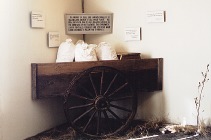

The first colony religious services at the Bishop Hill Colony were held in a tent built of logs and canvas. The tent was destroyed by fire and the three-story Colony Church was built during the summer of 1848.
 The building has three full floors and a partial balcony. During a housing shortage
early in the Colony's existence, the ground-level and the basement were used for apartments.
The church housed 20 families, each in one 100 square foot room.
The outside stairways on the north end of the church lead to the sanctuary on the
uppermost story.
The building has three full floors and a partial balcony. During a housing shortage
early in the Colony's existence, the ground-level and the basement were used for apartments.
The church housed 20 families, each in one 100 square foot room.
The outside stairways on the north end of the church lead to the sanctuary on the
uppermost story.
 The sanctuary holds 1000 people seated in handmade walnut pews. Lighting is with chandeliers
fitted with candles. Early each Christmas day, a candelight service (Julotta) is held in the
sanctuary. The service is non-denominational and is presented in Swedish and English.
The sanctuary holds 1000 people seated in handmade walnut pews. Lighting is with chandeliers
fitted with candles. Early each Christmas day, a candelight service (Julotta) is held in the
sanctuary. The service is non-denominational and is presented in Swedish and English.
The ground floor is now home to a Museum about Bishop Hill's history. The museum includes
a Please Touch Room, which is furnished with reproductions of Colony artifacts.
Items include beds and bedding, clothing, a desk, children's toys, and a spinning wheel.

Jonas Malmgren was born in Bolnass Parish, Sweden, the son of a master blacksmith. He served the Colony as a blacksmith and as head miller at the steam mill. The mill housed a wood turning lathe and other wood working tools. Included in the display is a Great Wheel Lathe, ca. 1850.
By 1848, the Colonists began firing their own brick, using clay from the nearby Edwards River. The Bishop Hill Colony Big Brick, built 1849-1851, was a 4-story, 96-room residence hall located a few blocks from the church. The building burned in 1928, but photos can be seen in the museum. Included in this display are bricks signed, initialled or decorated by the women, children who made brick, as well as a colony dog.

The sign above the wagon reads:
In January of 1843, Erik Jansson traveled to Halsingland Sweden to sell wheat flour. His real intenetion was to hold religious services in the farmyards of his followers. This charismatic leader eventually persuaded some 1200 of his wheat flour customers to follow him to America.
One of the Colonists, Pehr Jansson of Bishop Hill, wrote the following to his brother Carl in Sweden in a letter dated Feb 10, 1847:
"For the land we have taken is large and wide and is such as none of us realized was to be found in the world."The land surrounding the town was well-drained and had deep topsoil, allowing the colonists to plant year after year without fertilizing. Small groves of leafy trees, plums, apples, berries, and hops were abundant. By 1860, the Colony owned over 12,000 acres of land. Their best known crops were flax (for linen) and broom corn.
The museum is operated by the Bishop Hill State Historic Site.
![]() Didn't find what you wanted? Check our Illinois
Links.
Didn't find what you wanted? Check our Illinois
Links.